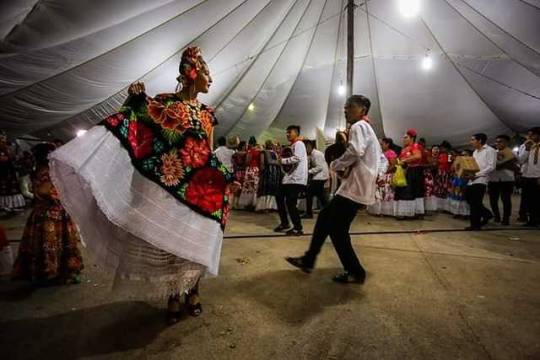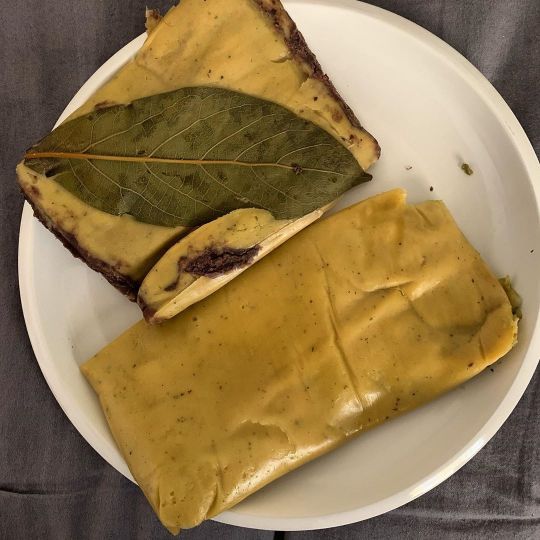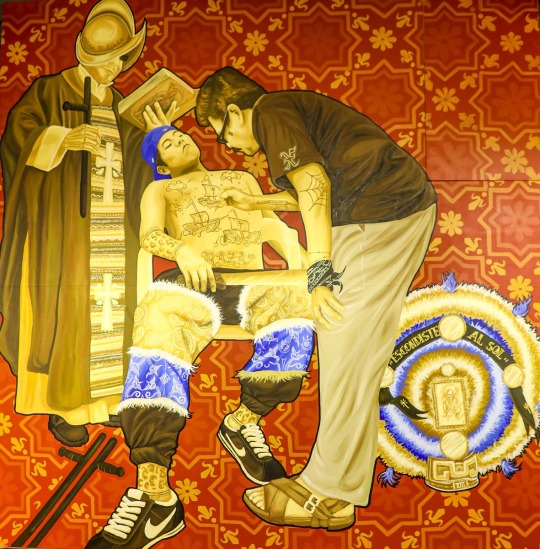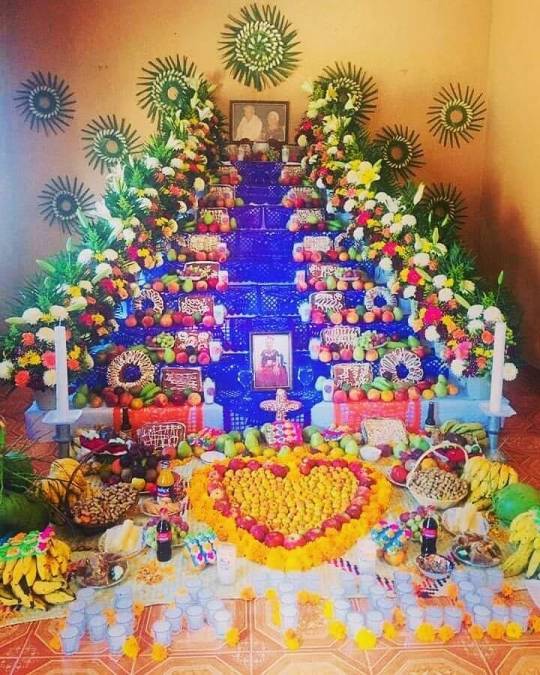#oaxacalifornia
Explore tagged Tumblr posts
Note
OMG fam ... from CP's photo dump... Christen and Tobin ate at OaxaCalifornia here in L.A.
Fam, I ALWAYS eat there at least twice a month.
Ohhhh, I'm NEVER getting over this one, fam. Nope. Never. Regret and self pity doesn't even begin to cover my feelingssss. If I had walked in and seen Tobin Heath and Christen Press on a cute lunch date together eating the delicious food of my heritage ... heart palps extravaganza.
OaxaCalifornia?!?! Are you serious.
lol 😂 maybe you’ll see them sometime
6 notes
·
View notes
Text
OaxaCalifornia : la comunidad oxaqueña en Los Ángeles
La población indígena migrante en Estados Unidos es cada vez más numerosa y, aunque muchas veces los indígenas en este país son etiquetados bajo la generalización de “latinos”, su presencia en zonas como el sur y el centro de California hace evidente que los integrantes de esta comunidad son particularmente vulnerables a la violación de derechos humanos, particularmente en las áreas agrícolas. El…
0 notes
Text
OAXACALIFORNIA
First up, enjoy a new Intro for the podcast! Followed by a few notes on the week from yours truly, including on the tragic passing of Mirna Soza while boarding L.A. Metro’s B Line on Monday, April 22nd, as well as on the Armenian Genocide of 1915, commemorated every year on Wednesday, April 24th. Then, from Columbia University to USC, this week belonged to Students for Palestine! In this spirit,…

View On WordPress
#2024#art#bracero program#California#immigration#Los Angeles#oaxacans#research#storytelling#uc berkeley
0 notes
Text
instagram
We urge you to take action and support the Zapotec communities of Los Valles Centrales in Oaxaca that have been impacted by these devastating wild fires. Our Indigenous Pueblos and cultures are continuously treated as commodities––being extracted from and exploited by the tourism industry and the Mexican government as objects of consumption and then disregarded in the face of disaster. The Mexican government and governor of Oaxaca @salomonjarac have failed to provide the necessary aid and resources to put out these fires. The Indigenous peoples of these Pueblos are forced to risk their lives to combat these fires on their own. We need your donations and active support to bring attention to these issues, mobilize, and show our active solidarity for those impacted by the fires.
Oaxacalifornia Presente!
#i saw this and i felt like sharing it here as well#i reblogged the stuff about the amazonian indigenous people too#idk it feels appropriate to support the people who were indigenous to the lands#that the countries represented on the server now control#donation requests#oaxaca#mexico#Instagram
0 notes
Photo

Vela de la Santa Cruz "Guuze' Benda" ("Los Pescadores"). Foto de Francisco Ramos. #oaxaca #oaxacamexico #visitoaxaca #oaxacatravel #oaxaca_bonito #oaxacacity #igersoaxaca #teesperoenoaxaca #oaxacalotienetodo #oaxacabonito #oaxacan #oaxacacultural #pasionxoaxaca #oaxacafood #oaxacalifornia #puertoescondidooaxaca #oaxacancuisine #oaxacanfood #oaxacaart #liveoaxaca #hechoenoaxaca #viveoaxaca #oaxacamagico #oaxacademisamores #oaxacavivo #oaxacalovers #oaxacadejuarez #instaoaxaca #oaxacastyle #oaxacafilmfest @ Juchitán de Zaragoza, Oaxaca (en Juchitán de Zaragoza, Oaxaca) https://www.instagram.com/p/Bw6BKRvlG6M/?igshid=1rj66r8qftt2n
#oaxaca#oaxacamexico#visitoaxaca#oaxacatravel#oaxaca_bonito#oaxacacity#igersoaxaca#teesperoenoaxaca#oaxacalotienetodo#oaxacabonito#oaxacan#oaxacacultural#pasionxoaxaca#oaxacafood#oaxacalifornia#puertoescondidooaxaca#oaxacancuisine#oaxacanfood#oaxacaart#liveoaxaca#hechoenoaxaca#viveoaxaca#oaxacamagico#oaxacademisamores#oaxacavivo#oaxacalovers#oaxacadejuarez#instaoaxaca#oaxacastyle#oaxacafilmfest
1 note
·
View note
Photo

Tamal de frijol y tamal de salsa verde. Haga su pedido en @ponchostlayudas. Feliz domingo. #LosAngeles #OaxaCalifornia (at Irvine, California) https://www.instagram.com/p/CBbqysaDLt8/?igshid=1sfzhwp1cczuk
0 notes
Photo

Tlacolulokos in LA
2 notes
·
View notes
Photo

Original Art by Miguel Angel @mitla_arte Available Now. Visit us at 3509 E 1st St LA CA 90063 Mon -Sat 10am - 7pm Sun & Holidays 10am - 5pm #mitlaarte #oaxacalifornia #originalart #artvision #artvisions #medicine #peyote #sunmoon #handpaintedceramic #nahuaceramic #eastlosfam #eastlosresident #welcometotheeastside #butterflies #papalotl (at Quetzal Boutique)
#eastlosfam#mitlaarte#sunmoon#artvisions#oaxacalifornia#nahuaceramic#originalart#welcometotheeastside#peyote#artvision#butterflies#eastlosresident#handpaintedceramic#papalotl#medicine
1 note
·
View note
Photo

Just sharing #theeskwilaxhour #art #arte #artist #artista #pintor #acrylic #mexican #culture #culturademexico #oaxaca #losangeles #california #sanlucasquiavini #oaxacalifornia #artevent #placitaolvera (at Los Angeles, California)
#artevent#art#culture#acrylic#oaxaca#california#mexican#pintor#arte#theeskwilaxhour#culturademexico#losangeles#artista#placitaolvera#oaxacalifornia#sanlucasquiavini#artist
1 note
·
View note
Text
Apodos Mecos de los Estados de México -es puro humor raza-
Aguascalientes: Aguascachondas (también conocida como Naguascalientes)
Baja California: Oaxacalifornia (por la comunidad oaxaqueña que ha emigrado)
Zacatecas: Zacatuercas, Zacatetas
Campeche: Cambache
Quintana Roo: Cantina Roo
CDMX: Chilangolandia, CeMenDeEquis (Cuando era DF se le conocía como: “El DeFectuoso” o “Defiéndete, Fuereño”)
Tamaulipas: Mataulipas, Tatatamaulipas, Tamaulipas pas pas
Chihuahua: Chihuas
Sinaloa: Saunaloa (por el calor)
Chiapas: Chiapasón
Querétaro: Quehuévaro, Pueblétaro
Guanajuato: Guanawashington
Oaxaca: Oaxashington
Guerrero: Warrior
Morelos: Morelhoyos
Hidalgo: Hindialgo
Puebla: Puebluca, Huachicolandia
Estado de México: Establo de México, PedoMex.
Michoacán: Michigan, Michoacalacas.
369 notes
·
View notes
Text
La importancia de denunciar los delitos de odio, si no hay reporte no hay crimen
Ya había terminado el foro: “La importancia de denunciar delitos de odio y cómo diferenciar los diferentes tipos de crímenes” cuando una compañera periodista se levantó y pidió la palabra. “Buenas tardes, un momentito de su atención por favor. Nadie de nosotros estamos exentos de sufrir un delito de odio”, expresó Cristina Ramírez, del podcast Crónicas en Oaxacalifornia. “Hace unos días un amigo…

View On WordPress
0 notes
Text
OAXACALIFORNIA: For the Pride of Your Hometown, The Way of the Elders, And In Memory of the Forgotten

“And That Is How They Hid The Sun” by Oaxacan art collective, Tlacolulokos (Dario Canul & Cosijoesa Cernas). This mural is part of a larger exhibit, OAXACALIFORNIA, which can be found online in the Museum of Latin American Art (MOLAA).
How & Why I Chose This Piece
The greater exhibit, OAXACALIFORNIA, showcases the complexities of language, migration, and culture specific to the experiences of Oaxacan (Oaxaca being the capital of Mexico) and Indigenous community members residing in Los Angeles, California. It aims to explore how these facets of identity have been integrated with that of non-Indigenous people (who function as agents of settler colonialism, regardless of intention), while simultaneously honoring the traditions of ancestors past. What immediately drew me to this specific piece was the juxtaposition of it’s red, gold, and blue colors. While the exhibit in its entirety uses the red and gold patterned background, it at once subverts this feeling of comfort with the choice to incorporate such a contrasting color such as blue in this specific mural. The blue also emphasized certain unrecognizable features of the mural and consequently piqued my interest.
Taking a step back to examine the actual people and objects situated in the work, I could already deduce that this was meant to provide commentary on a few key aspects of society; religion (due to the robed figure on the far left donning a black robe and a cross-patterned shirt), the relationship between policing systems and religion (as shown by the batons positioned to create a cross at the foot of the robed figure), and culture (demonstrated by the different styles of clothing each person is wearing). Additionally, the context of the exhibit is to reinforce the importance and presence of Indigenous life despite the consistent whitewashing of history. I could therefore conclude that this in one way or another was attempting to push against dominant colonial narratives and also attempting to remind spectators that this history is not stuck in the past. Colonization is frequently framed as an unnameable atrocity of the past, but it is not often enough recognized as a trauma that has manifested to fit our world today. This piece insists on being recognized as a contemporary struggle while also affirming the Indigenous peoples ability to thrive regardless of all that they face.
Despite knowing all this there was so much that was not familiar to me, such as the pants of the portrait’s middle character, their tattoos (or that of the person creating them), and the cultural artifact to the far right side. I was also really interested to see how language would be incorporated into a medium that was largely visual, and while we do see a phrase in Spanish, I was not yet sure about it’s meaning in the exhibit as a whole. I knew there was much more occurring than I could grasp based on my limited knowledge of Oaxacan and Indigenous communities, and it was my job to unravel that understanding from this mural. This is why I chose this piece. Not only does it echo a familiarity of colonial narratives that many of us grew up being educated on, but it de-centers this whitewashed history and instead encourages us to engage directly with the cultures of these communities. It forces us to dedicate time and effort to truly understand how this work is a piece of global resistance.
Reframing as Object of Resistance Global Novels are about expanding our world view, about circumventing structures that exist to repress all expressions of identity. In studying this genre, we have been able to access various works that asked us to consider the magnitude of storytelling. It is not enough to just acknowledge the existence of these stories, but we have been tasked with challenging the people who have been positioned to tell them. Art exhibits accomplish much (if not all or more) of the same things, and both mediums allow us to reflect on our own experiences and create interpretations that would not exist otherwise. OAXACALIFORNIA falls right in the middle of this mission as it is celebrating life, tradition, language, and reaffirming Indigenous communities' place in history and in the world today. It simultaneously collapses whitewashed narratives that have somehow tokenized Indigenous people in a way that suspends them in the past --- they are not honored as they exist in our communities now. Because this piece is framed within a colonial context, it is automatically assuming the position of a reimagined history. Both Canul and Cernas have expressed that the exhibit contains significant ties to Oaxacan, LA, and Indigenous cultures. Thus, this piece also functions by tying together generations of migration and stories. At face value this mural literally depicts several people, but there is a deeper underlying meaning that directly opposes the regurgitation of popular colonial accounts. Firstly, the Catholic priest on the far left is dressed in a black robe with patterned print underneath. The print contains imagery of the cross, and lying at this figure’s feet are two police batons that take on the shape of a cross. The battle helmet that they are wearing has the words “Born to Kill” engraved into the side, and they are wearing combat boots that are barely visible beneath the robe. This figure is also pictured holding a police baton in one hand (mimicking a crucifix) and an open religious text that is decorated with the imagery of death on the other. One should also note that the hand wrapping around the baton is skeletal, almost ghostly, and seems to mirror the picture of death on the open book. Combining all these characteristics together it is as if they are attempting to bless the person who is sitting down, but with promises of salvation through violence, policing, and deception (characterized by the fact that their face is being mostly shielded from the audience) much like the European conquistadors during the continent's pre-colonial era. This also calls forth the issue of police brutality that Black communities and communities of color face at the hands of the police officers, once again making this piece more contemporary than meets the eye. They are positioned in a way that makes them taller than the other two individuals, but they feel more blended in with the background as they are wearing duller colors. Next, we have a person who appears to be sitting down and getting drawn or tattooed on. Their chest, right arm, and ankles are covered in tattoos, and the ankle tattoos almost seem to mimic the print of their pants. They are wearing a bright blue cap backwards, dressed in sweats, and Nike sneakers. This person’s expression is one of bravado and they’re holding onto a machete, which is symbolic of resistance to the systemic, ideological, and physical violence experienced at the hands of colonizers. While that seems to be all that is going on, the emphasis of the bright blue colors led me to do research on the significance of the clothing. The sweatpants have actually been sown together with traditional wear for the highly respected “Danza de la Pluma/Dance of the Feather”. The dance is full of lively music, vibrant clothing, and the presence of ancestors (acted through the people dancing) that are meant to be honored. It existed long before colonization occurred and was specifically honoring the Aztec gods (i.e. of rain, sun and corn to name a few). After colonization it then began to also commemorate the survival of Indigenous peoples despite the violent intervention of Europe. The blending of traditional wear with the sweatpants and overall mainstream outfit (i.e. the only other blue accessory, the cap) are emblematic of the multiplicity of identity. Regardless of how much has changed sociopolitically, a person’s identity is their own to dictate and these identities do not exist in vacuums. Lastly, the person that seems to be tattooing is the more discreetly proactive character. The tattoos that have been drawn on the middle person’s chest are that of ships adorned with crosses on their masts, of lightning storms, and of the word “Raza/Race” on their abdomen. Because this last person is placed in a position of creating these images, this speaks more directly to the core of this project; the reimagining and rewriting of history by those who have been harmed. The waves lashing out at the base of the ships seem more fiery, like flames, and all of these combined illustrations create a tempestuous recounting of European colonization. These colonizers are the bringers of chaos in this story. It’s also important to note that this third person’s hand is dissolving into the body of the person sitting. Both people become one in this shared past and this tattooing process is consensual, reassuring the audience that both are partaking in the sharing of their truth. There is empowerment and autonomy here. While their expression is that of bravado (as mentioned earlier), the teardrop is representative that there is no bravery without expressions of pain and sadness. Whether this sadness is due to the remembrance of this agonizing past or the literal process of tattooing, it has become memorialized as part of their experience all the same. While religion was weaponized, it is also a testament of union and community. It is undoubtedly true that Christianity and Catholicism were vehicles of violence for the European settlers, but now that both have become ingrained as an integral part of certain Oaxacan communities (re: the tattoo of a rosary on the third person’s left hand), it has been reworked as a mode of unification and of finding each other. All of these truths can exist at once but it was imperative to Tlacolulokos to create a piece that was frank in it’s portrayal. This piece also transcends borders, such as those of California (LA) and Mexico (Oaxaca), and highlights the issues of Indigenous displacement. The theorist that immediately came to mind was Dr. Aihwa Ong, author of Flexible Citizenship: The Cultural Logics of Transnationality. Dr. Ong uses the imagery of a passport to disturb the conventions of “state imposed” versus “personal” identity. Not only does the passport symbolize a state imposed sense of identity (much like the creation of borders), but Ong outlines how a diasporan subject inherently resists these sanctions. Tlacolulokos have curated for us through their art the understanding that Indigenous people have been labeled as “other” and “inferior”, despite being displaced from their original land and right to sovereignty. There is an understanding that these marginalized groups now have learned to mold themselves around societally imposed expectations. Similarly, Ong explains that the concept of “citizenship” is always changing due to physical movement and displacement, and due to cultural exchange. This is exactly the rhetoric that this mural is attempting to emulate. In its entirety, this mural depicts the movement of people across borders (metaphorical and literal), and about the fact that these communities continue to exist regardless of how they are erased from institutional spaces. Despite the fact that the US government continues to ostracize and disrespect Indigenous people, these communities are continuing to find each other through the tracing of familial lines and self-identification. This exhibit addresses themes of being silenced by solidifying its place in history through documentation in a visual form. It is a memorialization of previously existing in a mythic state; of existing between reality and fantasy. However, this piece and the exhibit as a whole reassures audiences that these communities are very real and still deserving of appropriate recognition and care. On a final note, these pieces were commissioned by the Los Angeles City Central Library to counter the original murals that were situated on the museums walls. The original paintings (commissioned in 1933) depicted the European and Indigenous people in painfully biased ways --- the Indigenous as weak, submissive, and enslaved, while the Europeans were construed as symbols of power, wealth, and civility. The act of placing the new murals by Tlacolulokos directly underneath the older work is the museum’s way of addressing the pain that had been perpetuated by their previous commission. While I can’t speak to whether or not this is enough to rectify the harm done by the museum (as I myself am not Indigenous), Tlacolulokos has definitely embraced this as an amends.
--- Zenaida R.
2 notes
·
View notes
Photo

Una Tlayuda con tasajo #Oaxaca #oaxacalifornia (en Oaxaca City)
0 notes
Photo

2019 #Xhandu y #Xhandu’yaa: el camino a la #muerte en el #Istmo #oaxaqueño. #Oaxaca #oaxacacity #Mexico #OaxacaBonito #OaxacaAPie #oaxacalove #OaxacanFood #oaxacanart #oaxacandress #oaxacanpottery #Oaxacalifornia #oaxacamagico #oaxacaestademoda #oaxacarifa #oaxacan #oaxacadejuarez #oaxacacultural #oaxacatienesquevivirlo #oaxacanature #Oaxacawedding #oaxacancoffee #OaxacatambienesMexico #oaxacatacos (en Universidad del Istmo, campus Juchitan, Oaxaca) https://www.instagram.com/p/CHEfBjDBsnG/?igshid=11nhuh639cc0n
#xhandu#muerte#istmo#oaxaqueño#oaxaca#oaxacacity#mexico#oaxacabonito#oaxacaapie#oaxacalove#oaxacanfood#oaxacanart#oaxacandress#oaxacanpottery#oaxacalifornia#oaxacamagico#oaxacaestademoda#oaxacarifa#oaxacan#oaxacadejuarez#oaxacacultural#oaxacatienesquevivirlo#oaxacanature#oaxacawedding#oaxacancoffee#oaxacatambienesmexico#oaxacatacos
0 notes
Photo

Hey #LosAngeles. Antojo de #tamales oaxaqueños para el brunch del domingo? Aquí una opción para comprar. Parte de las ganancias irán a beneficio de #BlackLivesMatter. Hagan su pedido a @ponchostlayudas. ¡ESTÁN BUENÍSIMOS! . #LA #sundaybrunch #linkinbio #instafood #comidaoaxaqueña #oaxacalifornia https://www.instagram.com/p/CBFRcY4jw7-/?igshid=ij1nnbce4far
#losangeles#tamales#blacklivesmatter#la#sundaybrunch#linkinbio#instafood#comidaoaxaqueña#oaxacalifornia
0 notes
Video
instagram
Giving away pamphlet for the exhibit "OaxaCalifornia" at @wignallmuseum thank you @rebatra #mural #oaxacalifornia #printmaking #pavelacevedo #drawing #sketchbook #huaxyacac
0 notes